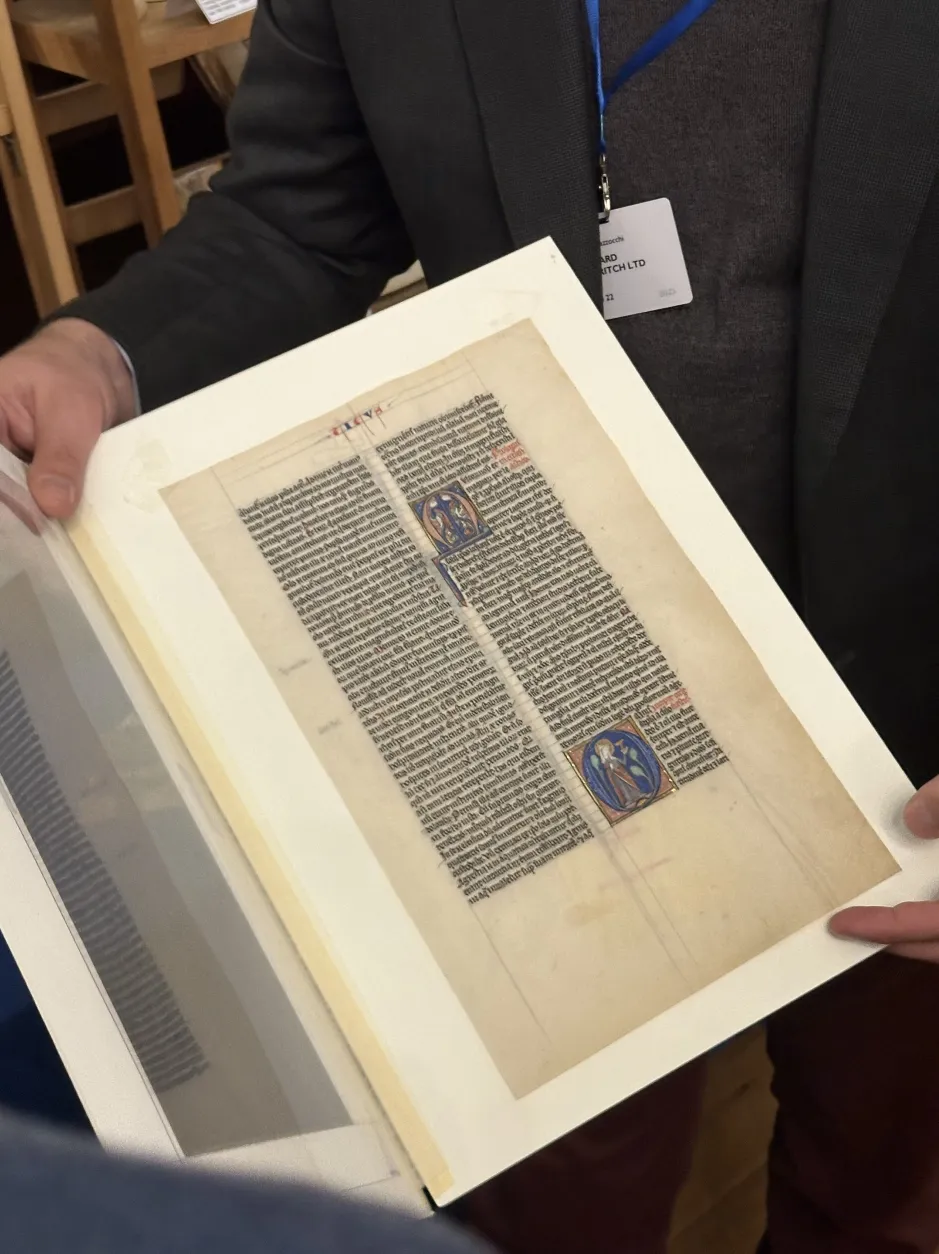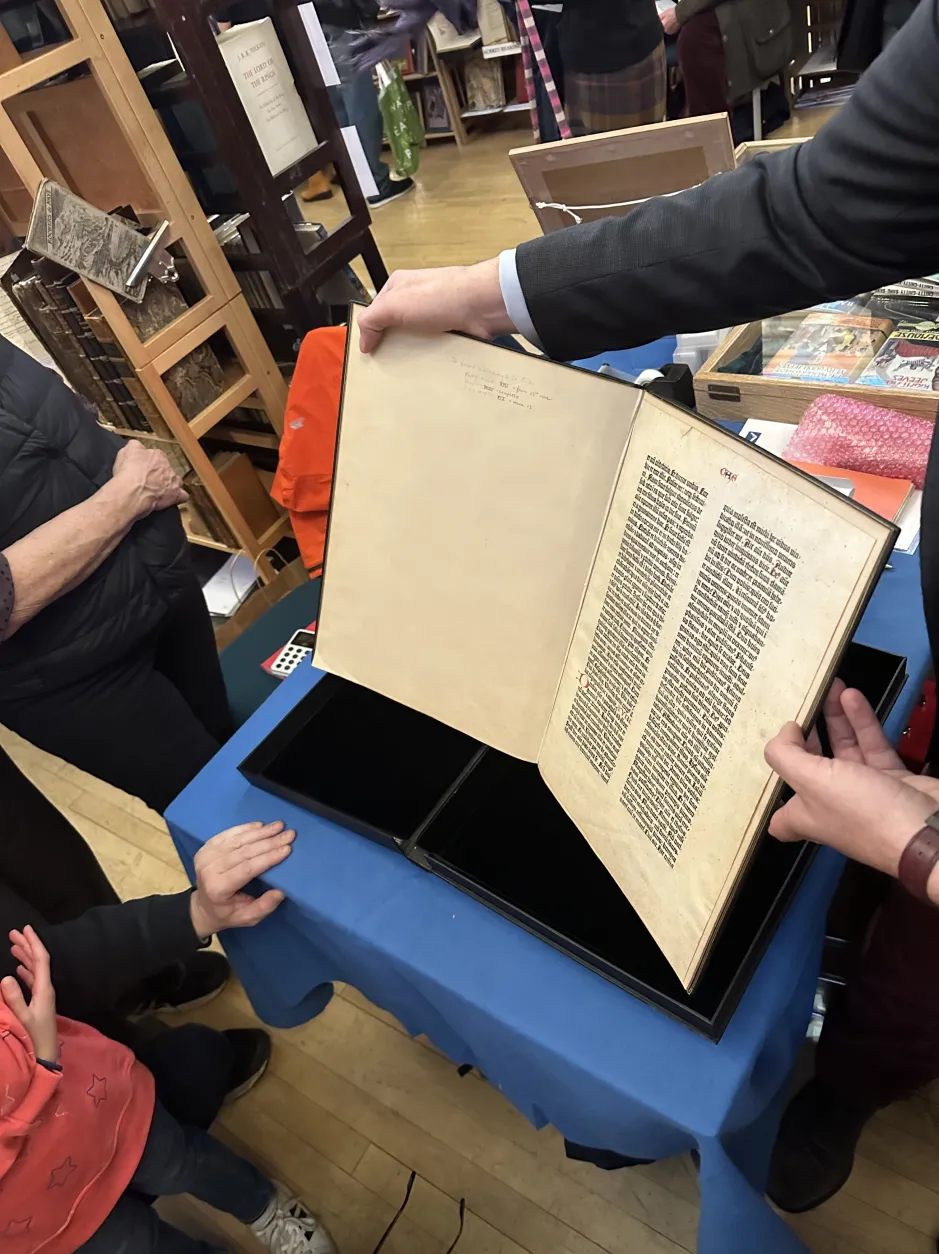Collecting Our Cultural Heritage: The Chelsea Rare Book Fair
- Anna Mowery
- Dec 1, 2023
- 5 min read
Updated: Dec 4, 2023

Collectors and curious bibliophiles attended the Chelsea Rare Book fair held at the Old Town Hall the first weekend of November. Nearly eighty booksellers transformed the historic building into a winding marketplace with bookshelves and tables displaying highly-curated selections of rare books dating from the early middle ages to the twenty-first century. In this one room, you could buy an illuminated manuscript from the 1400s and a first edition of Harry Potter. Both will cost an exorbitant amount of money (sometimes equivalent to a year of undergraduate education or a down payment on a house), but there are worse things to invest in.
The Antiquarian Booksellers’ Association (ABA) has hosted the Chelsea Rare Book Fair annually for over thirty years, bringing together some of the most incredible rare books, fine bindings, manuscripts, maps, artwork, and ephemera currently on the market. The fair attracts booksellers and collectors from all over the world, making this book fair one of London’s best. Although the idea of handling extremely valuable books and chatting with world-class booksellers may seem daunting to many newcomers to this corner of the book world, the ABA did an excellent job to make the book fair an accessible and inviting experience. Not only were the booksellers friendly and knowledgeable, but the ABA also enlisted a handful of them to give short talks and tours to highlight some of the most impressive items for sale and introduce people to the history of books and the book trade.

Interest in antiquarian books emerged around the seventeenth century as it became especially trendy among the gentry class to build repositories of intellectualism in the form of books, art, and other curiosities. Whether they were intending to or not, these early collectors helped preserve works of art and literature that we now consider national treasures. The only known manuscript of Beowulf, for example, was preserved in the collection of Sir Robert Cotton (1570-1631) and is now housed in the British Library. While some antiquarian collections end up in museums and libraries, others remain in private ownership. Antiquarian bookselling is an important, often forgotten part of our cultural heritage. This remarkable corner of the book trade places important, valuable books into the hands of individuals and institutions where they can be enjoyed and preserved for subsequent generations.
Every book has its own intricate history, shaped by the way society has embraced or rejected its contents and the material qualities that reflect its production and previous ownership. A book may look completely unremarkable on the outside, but contain a philosophical treatise that inspired proceeding generations of politicians, artists, writers, and more. For example, the short, thick vellum-bound book brought to the fair by Marshall’s Rare Books has one of the most nefarious histories, and yet it looked entirely unassuming. It was a copy of the Malleus Maleficarum, also known as The Witches’ Hammer, which warned sixteenth-century Europeans about the evils of witchcraft and fueled the fearful hysteria that led to the executions of several thousand people throughout the early modern period. Despite this book’s alarming history, it looked as innocent as the first edition copy of Jane Austen’s Sense and Sensibility for sale a few booths away.
In addition to a book’s place in the literary canon or its influence on society, a book’s history can also be visible through marks of previous ownership. These visible manifestations of where a book has been and who previously owned it display how a book has traveled through time, something that many collectors value. Every bumped corner, creased page, and annotation exhibits how that specific book has been loved (or hated) from the time of its production to its current place on the booksellers’ stand. Annotations trace readers’ thoughts, recording what passages they found important or interesting. Signatures and bookplates reveal the identities of previous owners. Sometimes you find personal or important inscriptions in books, like the association copy of Muriel Spark’s The Prime of Miss Jean Brodie which Spark inscribed to her editor. In cases like this association copy, as well as all the other signed first editions of beloved literary works brought to the fair by Jonkers Rare Books, marks of previous ownership add another layer to a book’s history.
While some collectors value these unique characteristics, others prefer to have a clean copy. Eighteenth-century collectors, for example, wanted books that looked pristine and untouched, so they would often wash their books with special detergents to whiten the pages. As the books aged, however, the detergents caused the pages to yellow to the point of deterioration. These early collectors also had their books stripped of their original bindings and re-bound to match their own individual tastes. Because this practice was so common, few early books survive with their original binding in good condition. Consequently, when you do come across a book with a contemporary binding in good condition, the book’s value can increase significantly. At a material level, these early collectors erased part of their books’ individual histories and replaced them with marks of their own ownership. In a way, they immortalized themselves as well as their habits, preferences, and interests in a visible way that reveals a great deal about the history of book collecting.
Another drastic example of how early collectors–or in this case early book dealers–left their mark on their books is the singular leaf of the Gutenberg Bible currently for sale by London-based bookseller Bernard Quaritch Ltd. The Gutenberg Bible is famously known as the first book ever made with movable type, a game-changing innovation for printing. Forty-eight known copies of the Gutenberg Bible survive today, only twelve of which are complete. Most of the Gutenberg Bibles are owned by institutions, but some have fallen into the hands of private collectors and book dealers. In the early 1900s, a New York book dealer acquired an imperfect copy of the Gutenberg Bible. He had the copy disbound to be sold as individual leaves, each of which is currently valued at around £50,000-100,000. The copies have since dispersed to every corner of the world, popping up on the market here and there in various forms. The singular leaf displayed at Quaritch Books’s booth, for example, had been bound into a folio-sized book along with a Bibliographical Essay by A. Edward Newton called The Notable Fragment.
In a way, books travel through time and often give us hints about where they’ve been and whose hands they've passed through. When you consider a book’s material qualities as well as their contents, you gain a full understanding of their value. Books reveal the interests and ideas that shaped society throughout the ages, and being able to see them and hear about them from the booksellers at the Chelsea Rare Book Fair was an invaluable experience.

Edited by Lara Mae Simpson, Literature Editor
All photos by Anna Mowery


























Comments